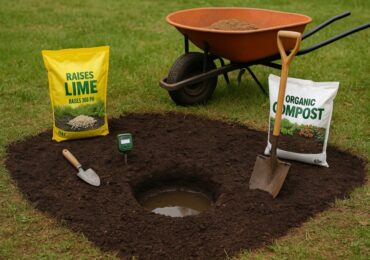Ordering fruit trees online is exciting—you get to choose from a wide range of varieties and imagine fresh fruit growing in your own backyard. But here’s the truth: the success of your nectarine tree depends less on the variety you choose and more on the ground you plant it in.
Before you buy nectarine trees varieties online, it’s worth spending some time preparing your garden soil. Healthy soil sets your tree up for strong roots, better growth, and a bigger harvest later on.
Here’s a simple guide to get your soil ready before your new tree arrives.
Step 1: Test Your Soil pH
Nectarines thrive in slightly acidic to neutral soil, with a pH between 6.0 and 7.0. If your soil is too acidic (below 6.0), nutrients like calcium become harder for roots to absorb. Too alkaline (above 7.5), and you risk iron deficiency.
You can buy an inexpensive pH test kit at any garden center. If results show your soil is off balance:
- Add lime to raise pH (reduce acidity).
- Add sulfur or organic compost to lower pH (reduce alkalinity).
Step 2: Check Drainage
Nectarine trees hate “wet feet.” Poorly drained soil can lead to root rot. A simple test:
- Dig a 12-inch hole in your planting area.
- Fill it with water and let it drain.
- Refill and time how long it takes to drain.
If it takes longer than 4–5 hours, your drainage is poor. You may need to plant on a mound or raised bed to improve conditions.
Step 3: Improve Soil Texture
Soil that’s too sandy drains water too quickly. Soil that’s too clay-heavy holds water too long. Nectarines prefer loamy soil—a balanced mix of sand, silt, and clay.
Here’s a quick comparison:
| Soil Type | Water Retention | Root Growth Impact | Fix |
| Sandy | Drains too fast | Roots may dry out | Add compost/organic matter |
| Clay-heavy | Holds water, poor air | Risk of rot, stunted roots | Add sand + compost |
| Loamy | Balanced moisture + air | Healthy root development | Ideal, maintain with mulch |
Adding organic compost each year helps move soil texture closer to loamy, no matter where you start.
Step 4: Remove Weeds and Grass
Before planting, clear the area around your tree—at least a 3-foot circle. Weeds and grass compete with young nectarine roots for water and nutrients. A clean space ensures your tree has the best start possible.
Step 5: Enrich with Compost or Fertilizer
Mix compost into the top 12–18 inches of soil before planting. This improves both structure and fertility. If you’re using fertilizer, look for a balanced formula with nitrogen, phosphorus, and potassium (NPK 10-10-10 works well). Avoid overdoing nitrogen—it encourages leafy growth but fewer fruits.
Step 6: Plan for Sunlight and Airflow
Soil prep isn’t just underground. Choose a spot with at least 6–8 hours of direct sunlight daily. Good air circulation also helps reduce fungal issues, which nectarines are prone to.
Why This Matters
According to research from the University of California Agriculture and Natural Resources, proper soil prep and placement can increase fruit yield by up to 40% compared to poorly prepared sites . That’s a huge payoff for a few hours of work before planting.
The Takeaway
Soil prep may not feel as exciting as choosing varieties, but it’s the foundation of success. Test your pH, check drainage, improve texture, clear weeds, and enrich with compost. Do this before you order, and by the time your new nectarine tree arrives, your soil will be ready to welcome it.
That little bit of planning now will reward you for years—with blossoms in spring and sweet nectarines in summer.
